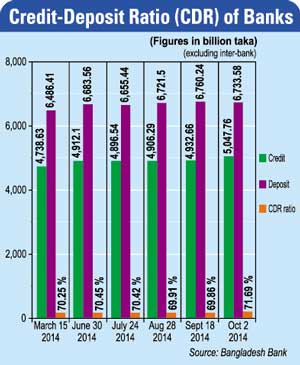
The overall flow of credit in the banking system marked a substantial rise recently despite a declining trend in deposits, bankers said.
As of October 2 last, the overall outstanding loans excluding inter-bank ones in the banking system grew by 2.33 per cent to Tk 5,047.76 billion from Tk 4,932.66 billion on September 18 last. It was Tk 4906.29 billion on August 28.
"The credit demand for trade finance along with commercial loans has increased recently because of declining trends of lending rates," a senior official of a leading commercial bank told the FE.
Most of the commercial banks are slashing interest rates on lending to attract good performing corporate clients, the banker explained.
"We expect that the rising trend of credit demand will continue in the coming months if the political stability continues," he noted.
Another banker has recommended to the central bank for taking necessary measures to ensure the use of such loan properly for minimising risks.
"Accelerated credit growth may fuel inflationary pressure on the economy if the end-uses of the credit are not ensured," the banker observed.
On the other hand, deposits with the banks fell by 0.39 per cent during the period under review as the funds have been diverted to different areas including risk-free government savings instruments.
Total deposit with the banks excluding inter-bank ones came down to Tk 6,733.58 billion as of October 2 from Tk 6,760.24 billion as of September 18 last. It was Tk 6,721.50 billion as on August 28, 2014.
"A significant amount of funds has already been diverted to savings instruments due mainly to higher interest rates, offered by the government than those of the banks," a senior official of a leading state-owned commercial bank (SoCB) told the FE.
Currently, average interest rate on fixed deposit, offered by the commercial banks, is around 8.50 per cent while that of savings instruments is, on an average, 13 per cent, according to the market operators.
The SoCB official also said, higher yield on the savings instruments is encouraging savers to divert their funds from the banks to the risk-free instruments.
"The banking system may face a shortage of loan-able funds in future if such trend of fund diversion continues," he noted.
Net sales of the national savings certificates increased by more than 225 per cent in the first quarter of the current fiscal year (FY) 2014-15, compared to the same period of the previous fiscal.
The net sales of the savings instruments rose to Tk 68.21 billion during the July-September period of the FY 15 from Tk 20.97 billion in the corresponding period of the FY 14.
Meanwhile, the credit-deposit ratio (CDR) of all the banks rose to 71.69 per cent, as of October 2 last, from 69.86 per cent as on September 18, 2014.
Higher credit growth than that of deposit has influenced the overall credit-deposit balance during the period under review, a senior official of the Bangladesh Bank (BB) told the FE.
"All banks' CDR may increase further in the coming months if the rising trend of credit growth continues," the central bank noted.
The BB earlier set the safe limit of CDR at 85 per cent for conventional banks and at 90 per cent for Sharia-based Islamic banks.
© 2024 - All Rights with The Financial Express
